

9. Literacy Instruction for Students with Intellectual and Developmental Disabilities – Steps to Success: Crossing the Bridge Between Literacy Research and Practice. This chapter addresses research-based literacy instruction for students with intellectual and developmental disabilities.
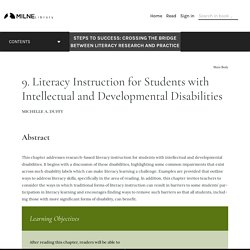
It begins with a discussion of these disabilities, highlighting some common impairments that exist across such disability labels which can make literacy learning a challenge. Examples are provided that outline ways to address literacy skills, specifically in the area of reading. In addition, this chapter invites teachers to consider the ways in which traditional forms of literacy instruction can result in barriers to some students’ participation in literacy learning and encourages finding ways to remove such barriers so that all students, including those with more significant forms of disability, can benefit.
Learning Objectives After reading this chapter, readers will be able to Students with intellectual and developmental disabilities have generally been taught literacy using a curriculum focusing on functional life skills (Katims, 2000). Presuming Competence Phonics. Power Point E-Books. Adapted Books- How and Why They’re a Great Resource. I hope that my post has inspired you to use adapted books in your classroom.
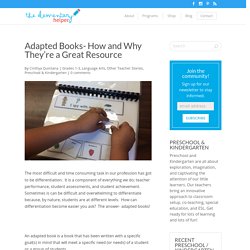
If you’re skeptical just remember that adapted books will make your planning, and small group instruction, much easier in a kinesthetic, child-centered way. Adapted books are easy to use and help make students responsible for their own leaning. It’s so much easier to get a student engaged in learning when there is a ‘game’ to be played and not just sitting through a story. Here at The Elementary Helper we love adapted books because they are the best way to differentiate work while keeping our students engaged!
Finding Adapted Textbooks and Other Reading Materials. Hi!
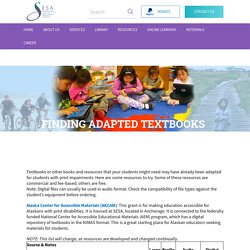
My name is Kelsey, this is my sign name. I am sharing this vlog with you so that you can learn a little more about who I am and what I do at SESA as a Deaf and Hard of Hearing education specialist. I am a certified Teacher of the Deaf and Hard of Hearing, with a background in Bilingual-Bicultural education. I graduated from Boston University, four- thousand miles away from Alaska. Making Books Accessible Physical and Electronic Adaptations (2) Understand what you read. Learn words with Rewordify.com.

Rewordify.com simplifies difficult English. Enter hard sentences (or whole chapters) into the yellow box at the top of the page. (You can also enter a web site URL.) Click Rewordify text and you'll instantly see an easier version, for fast understanding. The reworded words are highlighted— click them to hear and learn the original harder word. Do you dislike dictionaries because they're confusing and unhelpful? Adapting Books to Increase Accessibility. When you remember a favorite book or story from childhood, chances are you remember it as a multisensory experience.

Do you recall feelings, images, sounds and even smells that are part of those memories? Maybe a song or activity takes you right back to time spent with a parent, grandparent or teacher and a book or story you shared. Classroom Strategies. Aronson, E. (2000-2008).
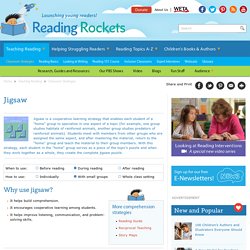
Jigsaw Classroom: Overview of the technique. Using Technology to Support Struggling Students: Science Literacy, Vocabulary and Discourse. Click the "References" link above to hide these references.
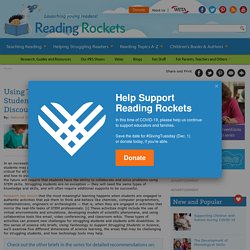
[i] Herrington, J., & Kervin, L. (2007). Authentic learning supported by technology: Ten suggestions and cases of integration in classrooms. Educational Media International, 44(3), 219-236.; Tan, S. Reading Adventure Packs for Families. Parents who read to their children everyday and talk about what they are reading together promote a joy of reading and literacy achievement.

How can teachers encourage reading at home and support the role of parents as educators? One way is through the use of our reading adventure packs — a paired set of theme-based fiction and nonfiction books and related interactive activities that kids bring home from school to share with their family. Compare, Contrast, Comprehend: Using Compare-Contrast Text Structures with ELLs in K-3 Classrooms.
It is a brisk October day in Chicago during my first year of teaching.
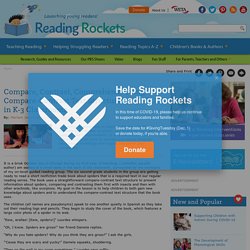
I (Jennifer, second author) am seated at a small table in the back of the classroom, surrounded by the members of my on-level guided reading group. The six second-grade students in the group are getting ready to read a short nonfiction trade book about spiders that is a required text in our regular reading series. Building World Knowledge: Motivating Children to Read and Enjoy Informational Text. Click the "References" link above to hide these references.

Chall, J., Jacobs, V., & Baldwin, L. (1990). The reading crisis: Why poor children fall behind. Cambridge, MA: Harvard University Press. Cooperative Children's Book Center (2006). Children's books by and about people of color. Duke, N., & Bennett-Armistead, V. Developing Academic Language: Got Words? Click the "References" link above to hide these references. Anderson, R.C., & Nagy, W.E. (1991). Linking the Language: A Cross-Disciplinary Vocabulary Approach.
Click the "References" link above to hide these references. Baumann, J.F., Edwards, E.C, Font, G., Tereshinski, C.A., Kame'enui, E.J., & Olejnik, S. (2002). How to Increase Higher Order Thinking. Higher order thinking (HOT) is thinking on a level that is higher than memorizing facts or telling something back to someone exactly the way it was told to you. HOT takes thinking to higher levels than restating the facts and requires students to do something with the facts — understand them, infer from them, connect them to other facts and concepts, categorize them, manipulate them, put them together in new or novel ways, and apply them as we seek new solutions to new problems.
Answer children's questions in a way that promotes HOT Parents and teachers can do a lot to encourage higher order thinking, even when they are answering children's questions. According to Robert Sternberg, answers to children's questions can be categorized into seven levels, from low to high, in terms of encouraging higher levels of thinking. While we wouldn't want to answer every question on level seven, we wouldn't want to answer every question on levels one and two, either. Level 1: Reject the question.
Concept-Oriented Reading Instruction (CORI) What is CORI? Content Area Literacy: Individualizing Student Instruction in Second-Grade Science. It is day two of Mrs. L's weekly science lesson and the "explain" day of the learning cycle. Students are reading the book Earthworms Underground (Beals, 2007) within their groups. Mrs. L is working closely with students in one particular group, because they need more scaffolding to complete their lab sheets; students in other groups are working together independently. Yesterday, the class recorded their observations of live earthworms as part of their "explore" day. Literacy in the Sciences. Many of the skills that are critical for growing strong readers and writers are also core skills in the study of science and math. Many kids struggle with reading – and children of color are far less likely to get the help they need.